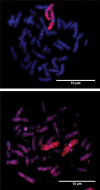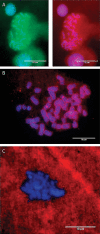Nanotechnology and molecular cytogenetics: the future has not yet arrived
- PMID: 22110858
- PMCID: PMC3215214
- DOI: 10.3402/nano.v1i0.5117
Nanotechnology and molecular cytogenetics: the future has not yet arrived
Abstract
Quantum dots (QDs) are a novel class of inorganic fluorochromes composed of nanometer-scale crystals made of a semiconductor material. They are resistant to photo-bleaching, have narrow excitation and emission wavelengths that can be controlled by particle size and thus have the potential for multiplexing experiments. Given the remarkable optical properties that quantum dots possess, they have been proposed as an ideal material for use in molecular cytogenetics, specifically the technique of fluorescent in situ hybridisation (FISH). In this review, we provide an account of the current QD-FISH literature, and speculate as to why QDs are not yet optimised for FISH in their current form.
Keywords: FISH; imaging; nanotechnology; quantum dot.
Figures








Similar articles
-
Quantum dots as new-generation fluorochromes for FISH: an appraisal.Chromosome Res. 2009;17(4):519-30. doi: 10.1007/s10577-009-9051-0. Epub 2009 Jul 31. Chromosome Res. 2009. PMID: 19644760
-
Semiconductor quantum dots for bioimaging and biodiagnostic applications.Annu Rev Anal Chem (Palo Alto Calif). 2013;6(1):143-62. doi: 10.1146/annurev-anchem-060908-155136. Epub 2013 Mar 20. Annu Rev Anal Chem (Palo Alto Calif). 2013. PMID: 23527547 Free PMC article. Review.
-
Brain and Quantum Dots: Benefits of Nanotechnology for Healthy and Diseased Brain.Cent Nerv Syst Agents Med Chem. 2018;18(3):193-205. doi: 10.2174/1871524918666180813141512. Cent Nerv Syst Agents Med Chem. 2018. PMID: 30101720
-
Quantum dots: from fluorescence to chemiluminescence, bioluminescence, electrochemiluminescence, and electrochemistry.Nanoscale. 2017 Sep 21;9(36):13364-13383. doi: 10.1039/c7nr05233b. Nanoscale. 2017. PMID: 28880034 Review.
-
Luminescent quantum dots for multiplexed biological detection and imaging.Curr Opin Biotechnol. 2002 Feb;13(1):40-6. doi: 10.1016/s0958-1669(02)00282-3. Curr Opin Biotechnol. 2002. PMID: 11849956 Review.
Cited by
-
Advances in Solution-Processed Blue Quantum Dot Light-Emitting Diodes.Nanomaterials (Basel). 2023 May 22;13(10):1695. doi: 10.3390/nano13101695. Nanomaterials (Basel). 2023. PMID: 37242111 Free PMC article. Review.
-
Properties, Preparation and Applications of Low Dimensional Transition Metal Dichalcogenides.Nanomaterials (Basel). 2018 Jun 26;8(7):463. doi: 10.3390/nano8070463. Nanomaterials (Basel). 2018. PMID: 29949877 Free PMC article. Review.
-
Zwitterion and Oligo(ethylene glycol) Synergy Minimizes Nonspecific Binding of Compact Quantum Dots.ACS Nano. 2020 Mar 24;14(3):3227-3241. doi: 10.1021/acsnano.9b08658. Epub 2020 Mar 11. ACS Nano. 2020. PMID: 32105448 Free PMC article.
-
Telomere Distribution in Human Sperm Heads and Its Relation to Sperm Nuclear Morphology: A New Marker for Male Factor Infertility?Int J Mol Sci. 2021 Jul 15;22(14):7599. doi: 10.3390/ijms22147599. Int J Mol Sci. 2021. PMID: 34299219 Free PMC article.
-
State of diagnosing infectious pathogens using colloidal nanomaterials.Biomaterials. 2017 Nov;146:97-114. doi: 10.1016/j.biomaterials.2017.08.013. Epub 2017 Aug 17. Biomaterials. 2017. PMID: 28898761 Free PMC article. Review.
References
-
- Chan WC. Bionanotechnology progress and advances. Biol Blood Marrow Transplant. 2006;12:87–91. - PubMed
-
- Parak WJ, Gerion D, Pellegrino T, Zanchet D, Micheel C, Williams SC, et al. Biological applications of colloidal nanocrystals. Nanotechnology. 2003;14:R15–R27.
-
- Jaiswal JK, Simon SM. Potentials and pitfalls of fluorescent quantum dots for biological imaging. Trends Cell Biol. 2004;14:497–504. - PubMed
-
- Reed MA, Bate RT, Bradshaw WM, Duncan WR, Frensley JWL, Shih HD. Spatial quantization in GaAs-AlGaAs multiple quantum dots. J Vac Sci Technol B. 1986;4:358–60.
-
- Miller DAB, Chemla DS, Schmittrink S. Absorption saturation of semiconductor quantum dots. J Opt Soc Am B. 1986;3:42.
LinkOut - more resources
Full Text Sources
Other Literature Sources
